Chile are two-time Copa América winners, achieving the feat in back-to-back years—2015 and 2016.
However, La Roja enter the 2024 edition of the tournament as underdogs, with an ageing squad perhaps not inspiring the most belief among supporters that 2024 is the year they’ll return to the summit of the Americas in the football realm.
This tactical analysis and team-focused scout report acts as a tactical preview, guiding you through what you can expect from Ricardo Gareca’s side at Copa América.
We’ll provide an in-depth analysis of Chile’s tactics leading up to this tournament in possession, out of possession, and in transitions, as well as outlining our predicted starting XI, overall squad, and key player.
Let’s get into it, then.
Predicted Starting XI
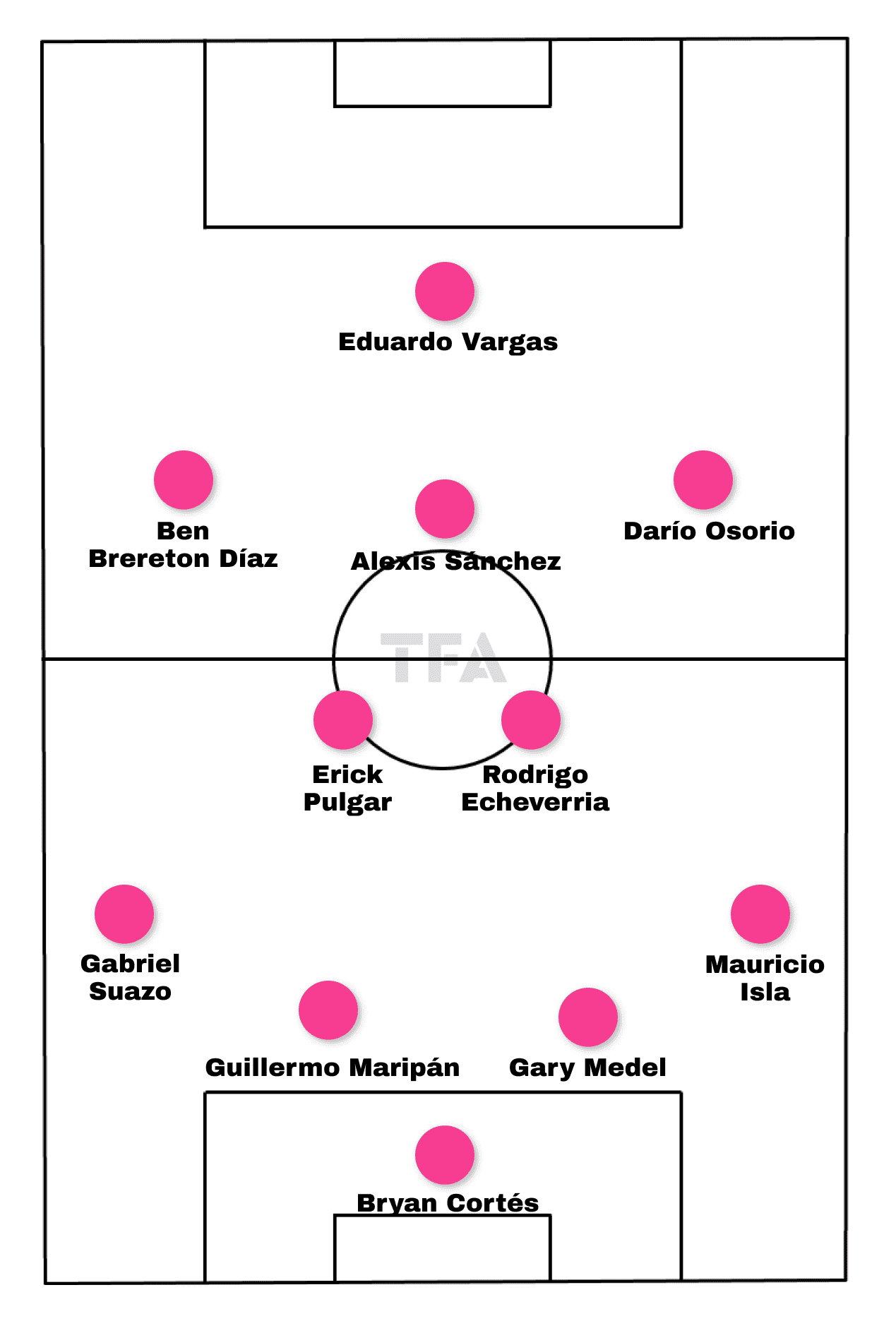
We foresee Chile lining up in a 4-2-3-1 shape, with Colo-Colo’s Bryan Cortés likely to get the nod ahead of veteran goalkeeper Claudio Bravo between the sticks.
We’ve got Mauricio Isla starting at right-back alongside Gary Medel at right centre-back, with Gabriel Suazo and Guillermo Maripán making up the left side of defence at left-back and left centre-back, respectively.
Our predicted lineup sees Erick Pulgar and Rodrigo Echeverria form the base of Chile’s midfield behind an attacking midfield trio of Ben Brereton Díaz on the left, Darío Osorio on the right and Alexis Sánchez as the ‘10’ in central attacking midfield behind Eduardo Vargas as the striker — though the attacking four, especially the ‘10’ and centre-forward, are likely to rotate quite frequently.
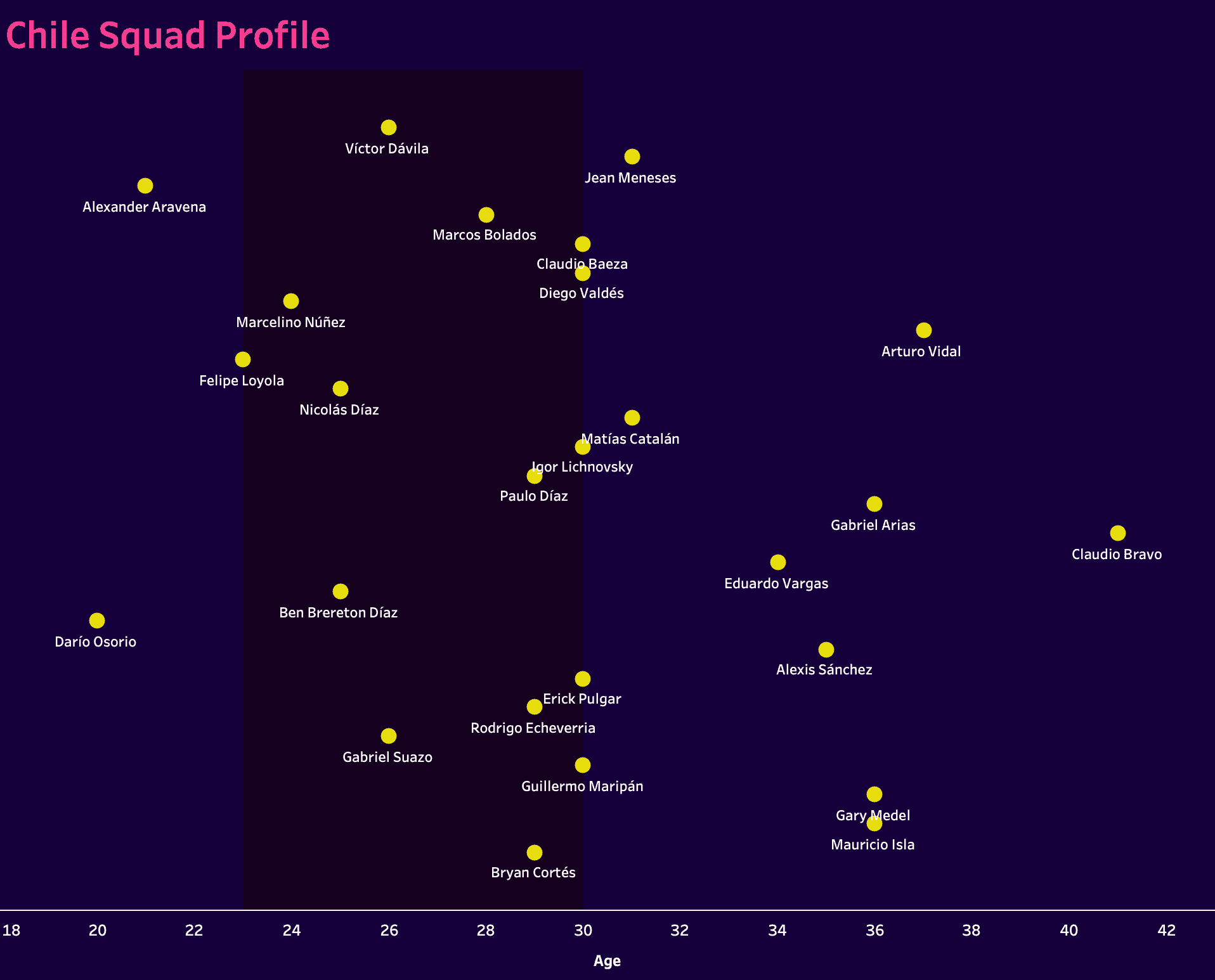
Figure 2 displays Chile’s age distribution graph according to the squad we believe is most likely to make the trip to Copa América this summer.
One or two of these calls may be off, but this is largely what you can expect to see as Gareca’s options come kick-off in game one versus Peru.
Just three players fall into the youth age range of 23 and under, with Osorio the only one of those making it into our predicted starting XI.
Meanwhile, a whopping 14 players, including eight members of our starting lineup above, fall into the ‘experienced’ age range of 30+.
This highlights a deep issue within Chile’s current footballing setup: a lack of quality in the peak and youth age brackets to replace those who may well be entering their final Copa América—or will at least be thinking about the end of their playing days—such as Sánchez, who has been and remains a star for the national team for many years but undoubtedly hasn’t got that much mileage left in him as a professional footballer.
There’s a big, undesirable skew towards older players within the current Chile setup, which has to be cause for concern for those managing the nation’s footballing development.
Unless something changes rapidly, there could be some difficult years ahead based on current trends.
Attacking phase
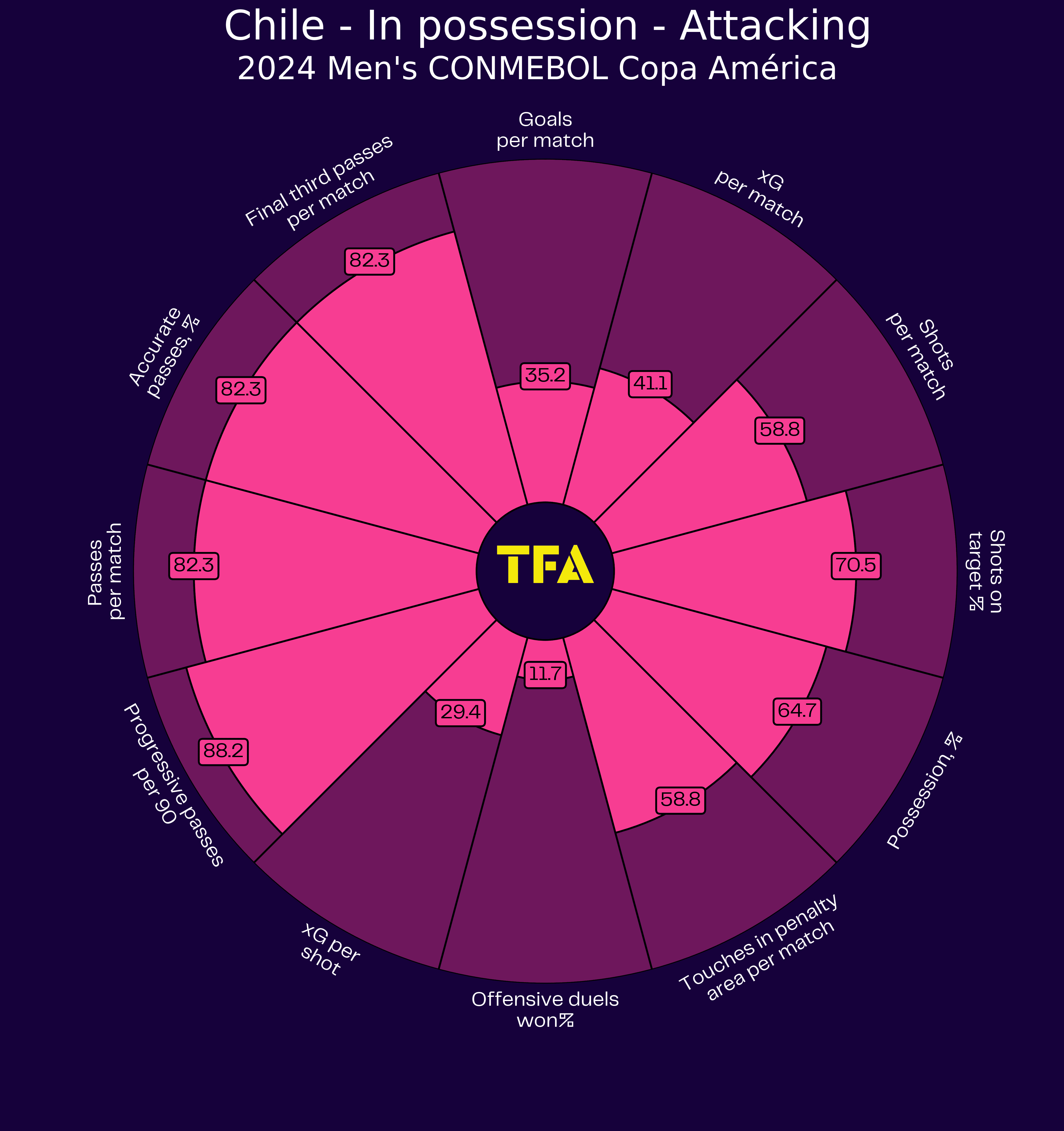
Not to keep piling on La Roja, but looking at the pizza chart above—highlighting their percentile ranks in critical metrics relating to the attack using data taken from all of Chile’s games played over the last calendar year and compared with their Copa América 2024 competition—they probably won’t strike fear into the hearts of defences they come up against purely through recent performances.
Yes, they’ve managed to keep a decent amount of possession in recent fixtures, but at the same time, they’ve failed to do much with that possession when looking at some average shots per 90, xG per 90 and — worse still — goals per 90 percentile ranks, all of which fall short of the top brackets in comparison to their Copa América rivals.
Furthermore, Chile’s xG per shot for this period falls in the 29th percentile, indicating that even when they do create shots, they tend to be more on the speculative end rather than clear-cut chances.
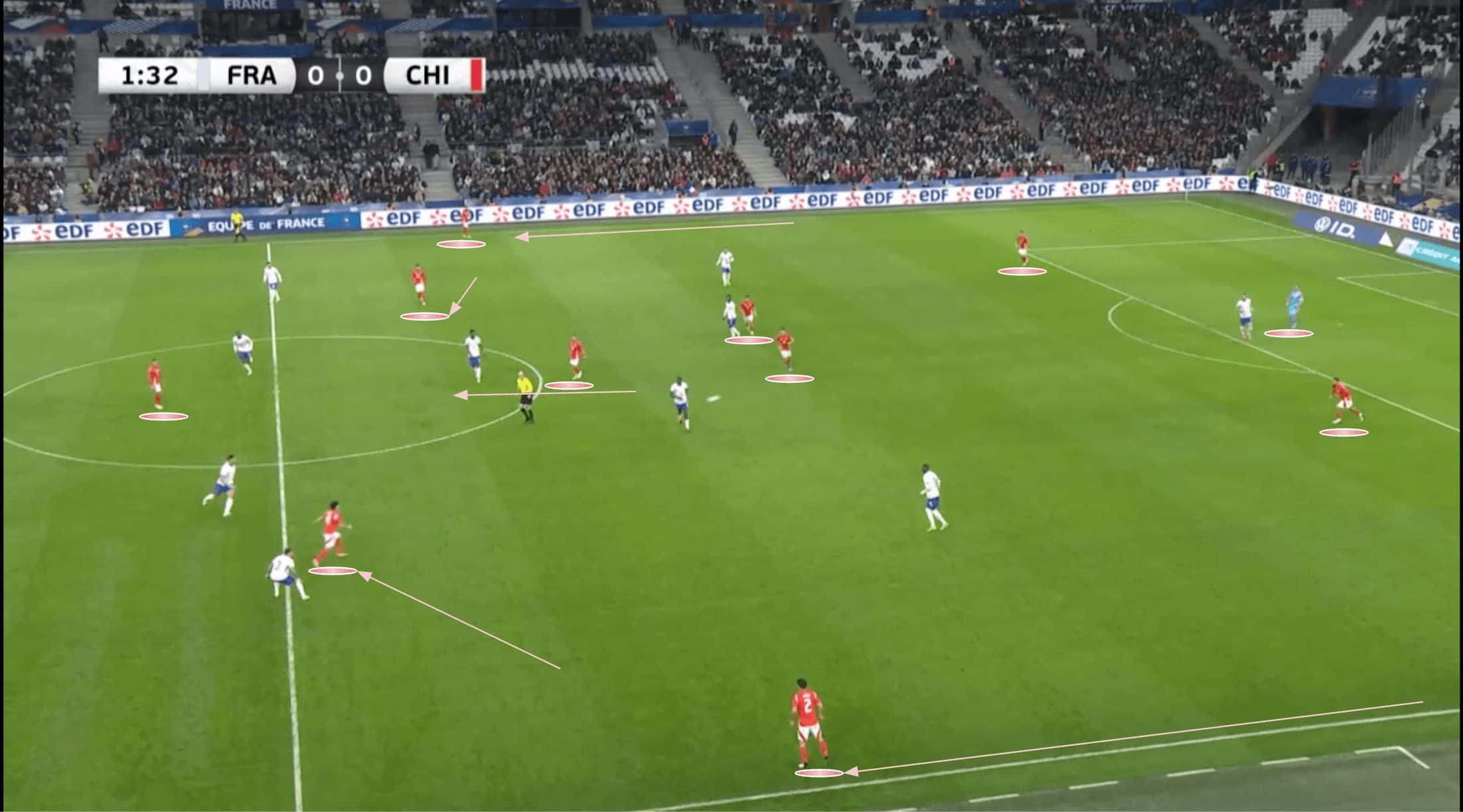
Figure 4 shows how we can typically expect to see Chile shape up in possession.
Their full-backs may push up outside the wingers, who will invert slightly, with the ‘10’ positioned just behind the wide men and in front of the double pivot.
They won’t be too hesitant to go long from the build-up, with long balls played towards the striker or left-winger, Brereton-Díaz, not infrequent at all — nor are balls into the channels and over the top for the attackers to chase in behind.
When the ball is played long towards the forwards and attacking midfielders, expect to see Chile aim to pull off some quick combinations with the front four generally positioned quite close together and likely to move to find space and create opportunities for one another to spring a ball in behind with the aim of unlocking the opposition’s backline and creating an opportunity on goal.
During their attacks, the shape they play with naturally creates a 2-2 base, with the centre-backs and holding midfielders forming a protective square, of sorts, in front of the goalkeeper.
This four-player base will help them defend in transition should they turn the ball over, but they’ll also rely on the attackers and full-backs to track back diligently and quickly, as we’ll discuss in greater detail later in this tactical analysis.
Apart from the quick passing combinations and direct play from the back, expect Chile to be relying a fair bit on individual brilliance at times, with the likes of Sánchez and Osorio sure to be to their side’s attacking success through the dribbling, playmaking and goalscoring qualities that they bring to the table.
Defensive phases
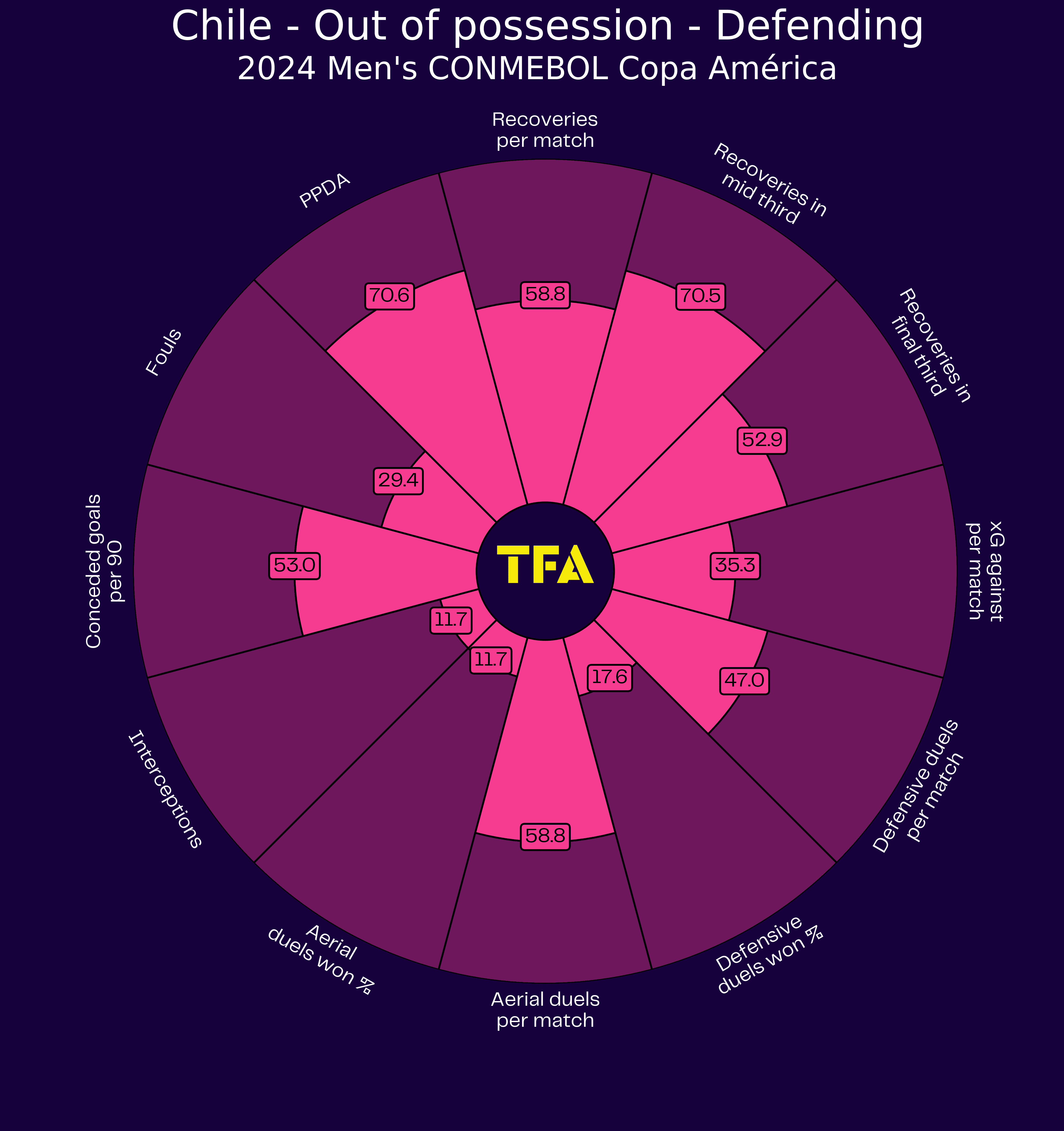
Turning our attention to Chile’s out-of-possession play, figure 5 displays another pizza chart — this time focusing on their performance in key defensive metrics in relation to their Copa América opponents based on their performances over the last calendar year.
The main takeaway from the viz above is that Chile has quite a high percentile rank in PPDA, indicative of their tendency to press fairly aggressively without the ball.
Meanwhile, they mainly stand out for their recoveries in the middle third of the pitch, ranking fairly average compared to their opponents for recoveries in the final third.
However, Chile’s performance in duels is cause for concern, with Gareca’s side performing poorly in defensive and aerial duels over the last calendar year.
This highlights some possible weaknesses in ground and aerial duels that opponents may aim to target this summer.
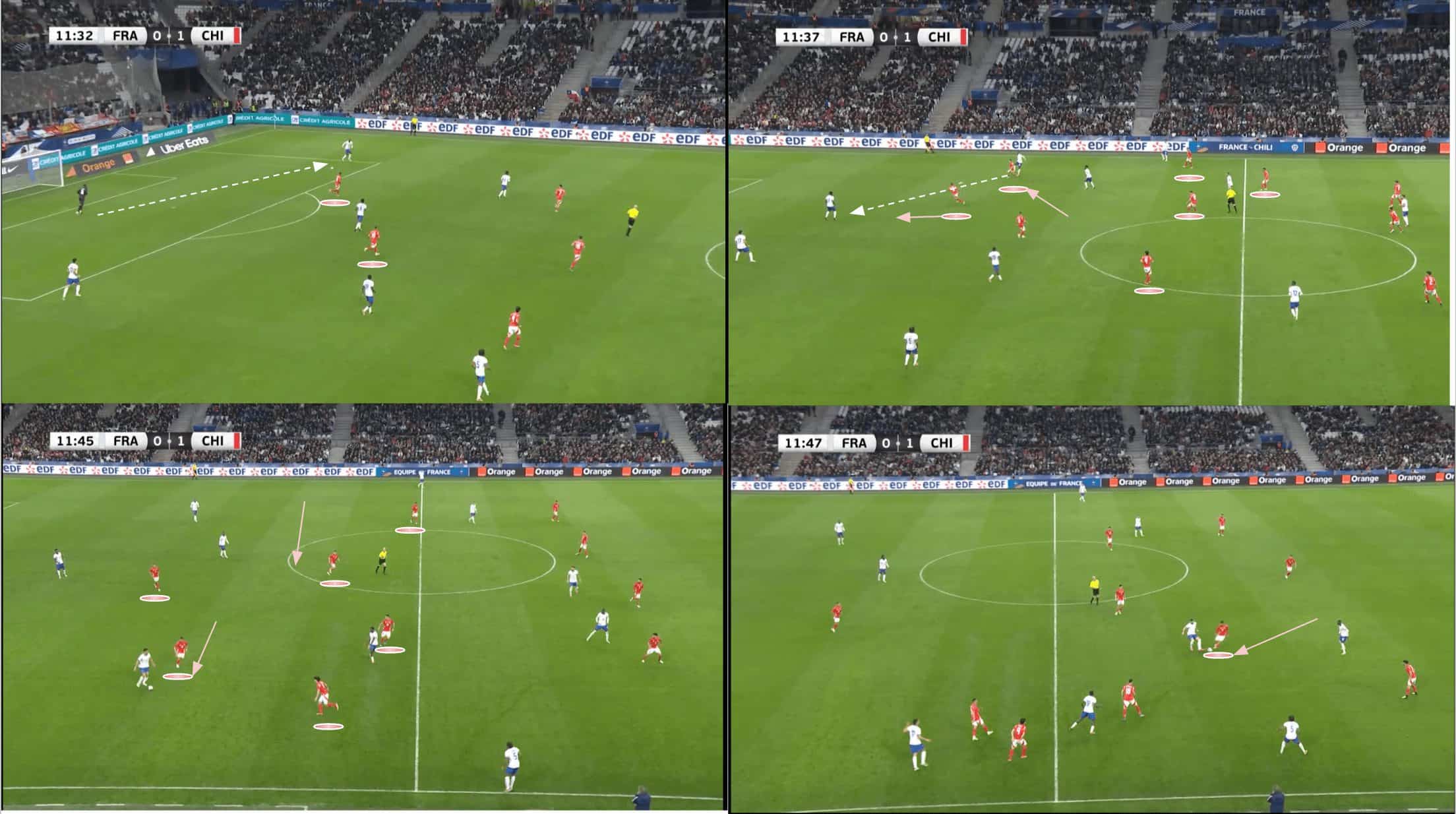
Chile typically press in a 4-4-1-1 shape, with the striker and ‘10’ alternating frequently between pressing the centre-back and dropping onto the holding midfielder, so either can act as the ‘centre-forward’ or ‘10’ at different moments, essentially.
Furthermore, as the top-right image of figure 6 shows, their defensive shape is often quite narrow in the mid-block, which offers great coverage of central areas without the ball.
As the centre gets covered sufficiently when the opposition play the ball out wide on one side of the pitch with Chile’s winger from the opposite side shifting over, this allows the ball-near winger to safely push out and close down the receiver out wide on that side of the pitch as we see here in both the top-right and bottom-left images above, with the bottom-left showing how Chile stay organised, protecting the centre while shifting over from right to left.
Should the ball get played in behind the midfield line, La Roja’s centre-backs retain the license to jump out from the backline and close down the receiver between the lines, as we see in the bottom-right image here, though this has had mixed results for Chile in recent games, as their poor record in defensive duels indicates, so it remains an area of improvement for them.
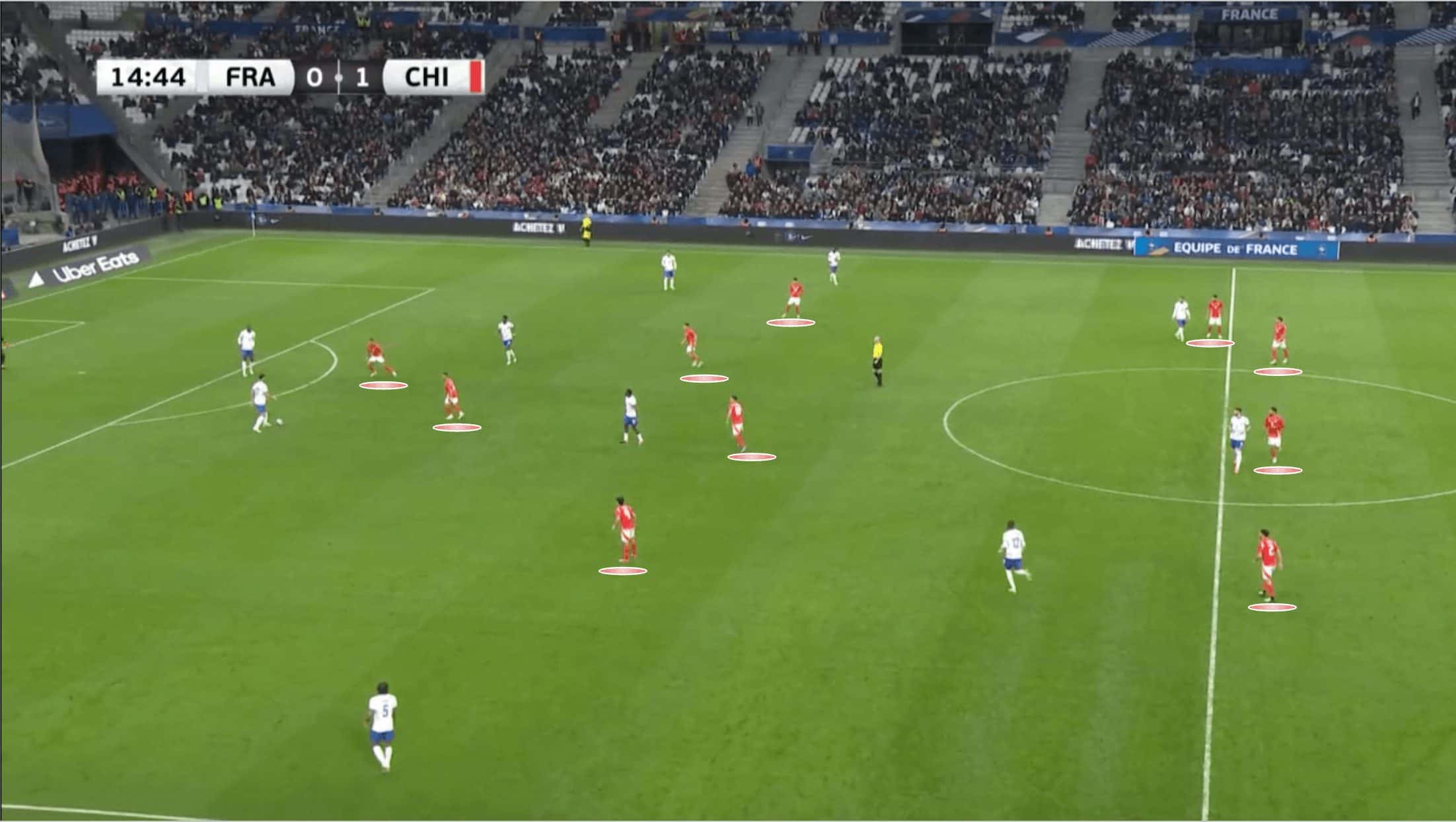
Furthermore, while their attackers press aggressively, they might allow space to open behind them for opposition midfielders to exploit.
This might force Chile’s midfielders to advance, and as we see in figure 7, this can result in large gaps opening between Chile’s midfield and defensive lines.
They need to be careful about allowing this much space for the opposition to target in Copa América, as it is a weakness that top opponents will not need an invitation to exploit.
Transitions
Attacking transitions are surely an area that Chile will be banking on exploiting heavily during this tournament if they’re to have any chance of achieving relative success.
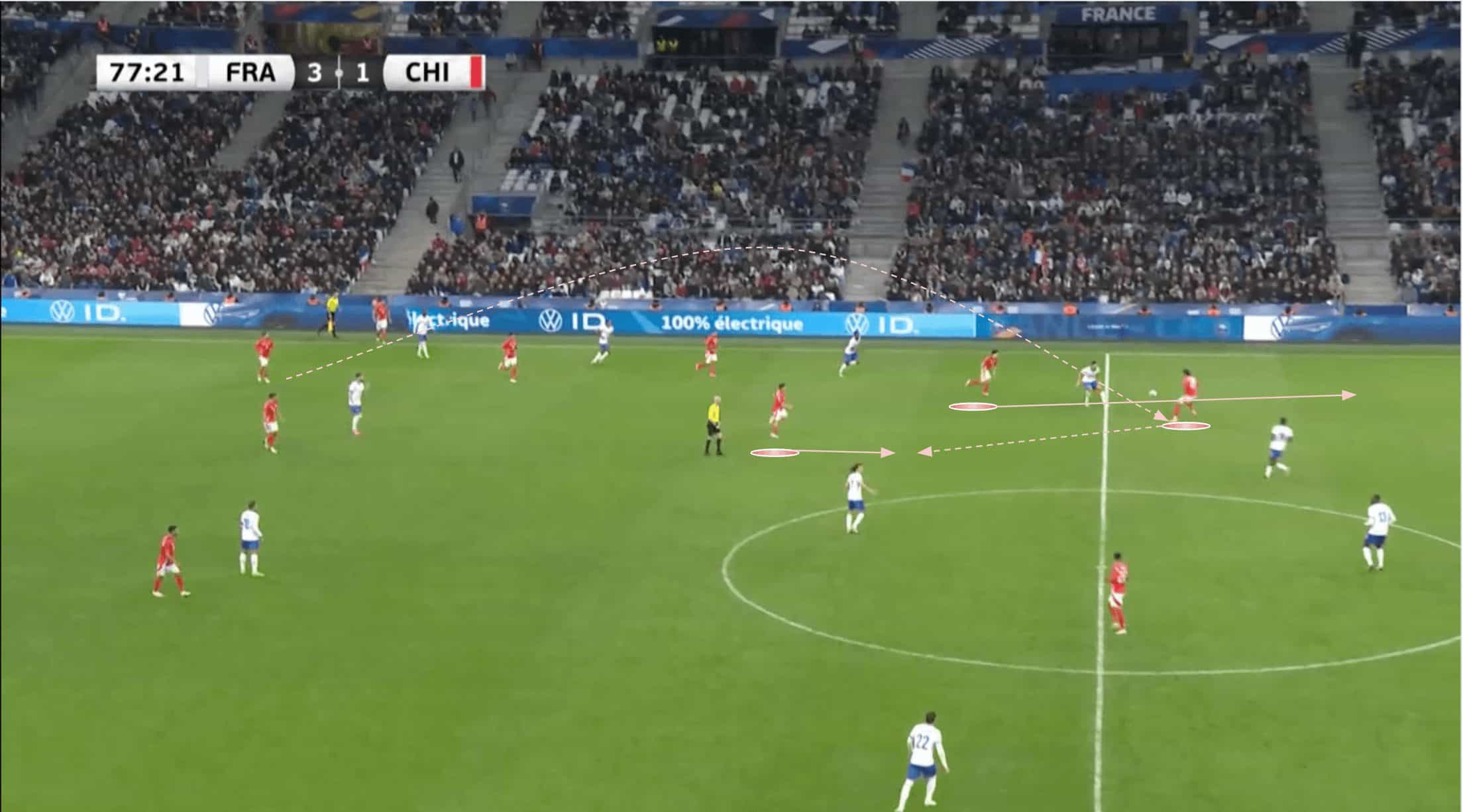
As mentioned earlier, long passes into the attackers will be commonplace both in settled attacks and transitional attacks.
Expect those passes and the subsequent combinations between the attackers to be particularly effective on the counter when the opponent’s defence is a bit weaker structurally, creating openings for the likes of Brereton-Díaz, Osorio, Sánchez, and Vargas to capitalise on.
We see one instance of Chile’s striker receiving the long ball and laying it off to the ‘10’ before turning and making a run in behind, alongside left-winger, in figure 8 above.
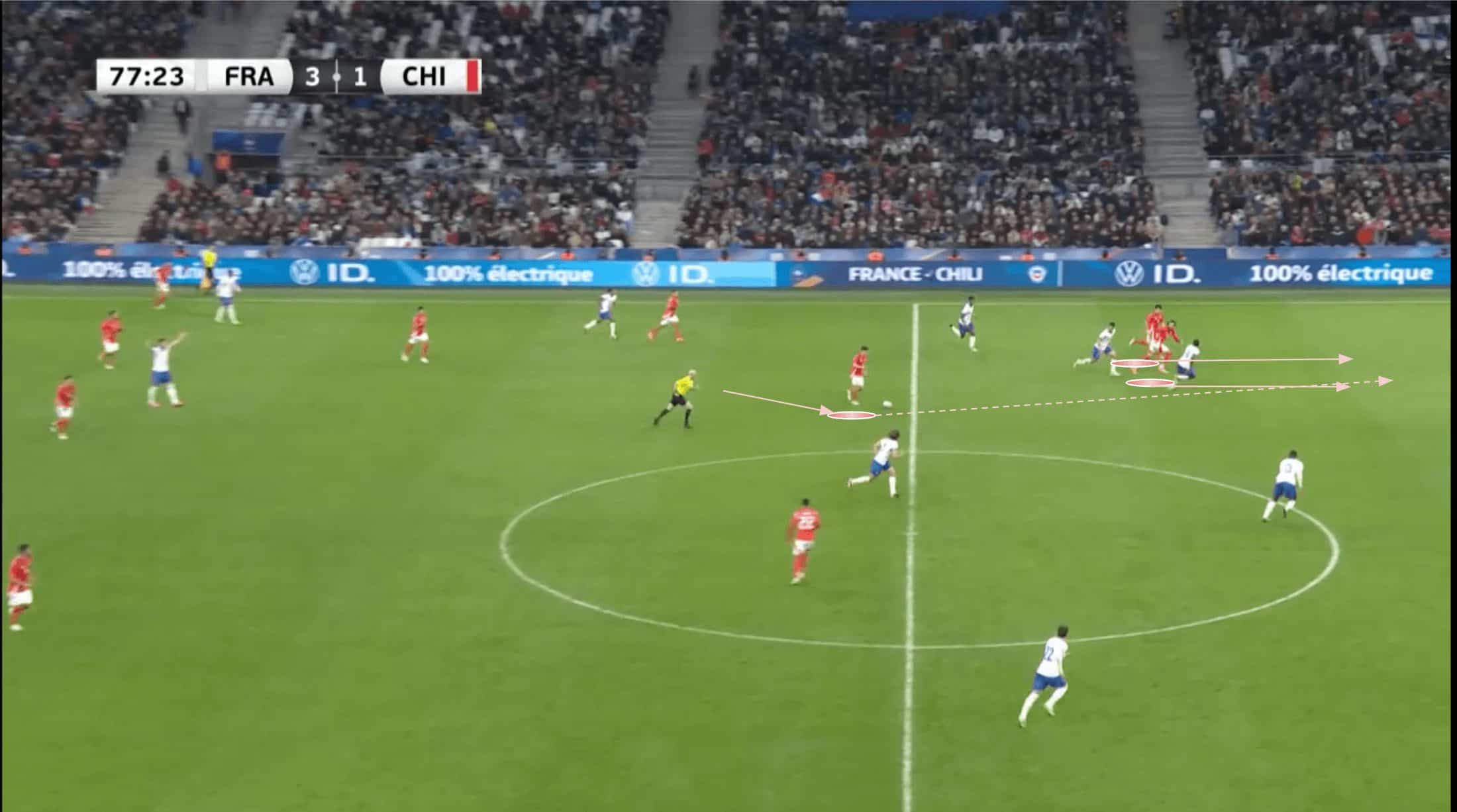
As play moves on, we see the ‘10’ has received and begun carrying the ball forward, breaking into the opposition’s half with two good passing options ahead — the striker and left-winger — both looking to exploit the space afforded to them behind the opposition’s backline.
From here, we see Chile go on to break the opposition’s backline with a well-timed and well-weighted through ball that set them up to go on and enter the penalty box.
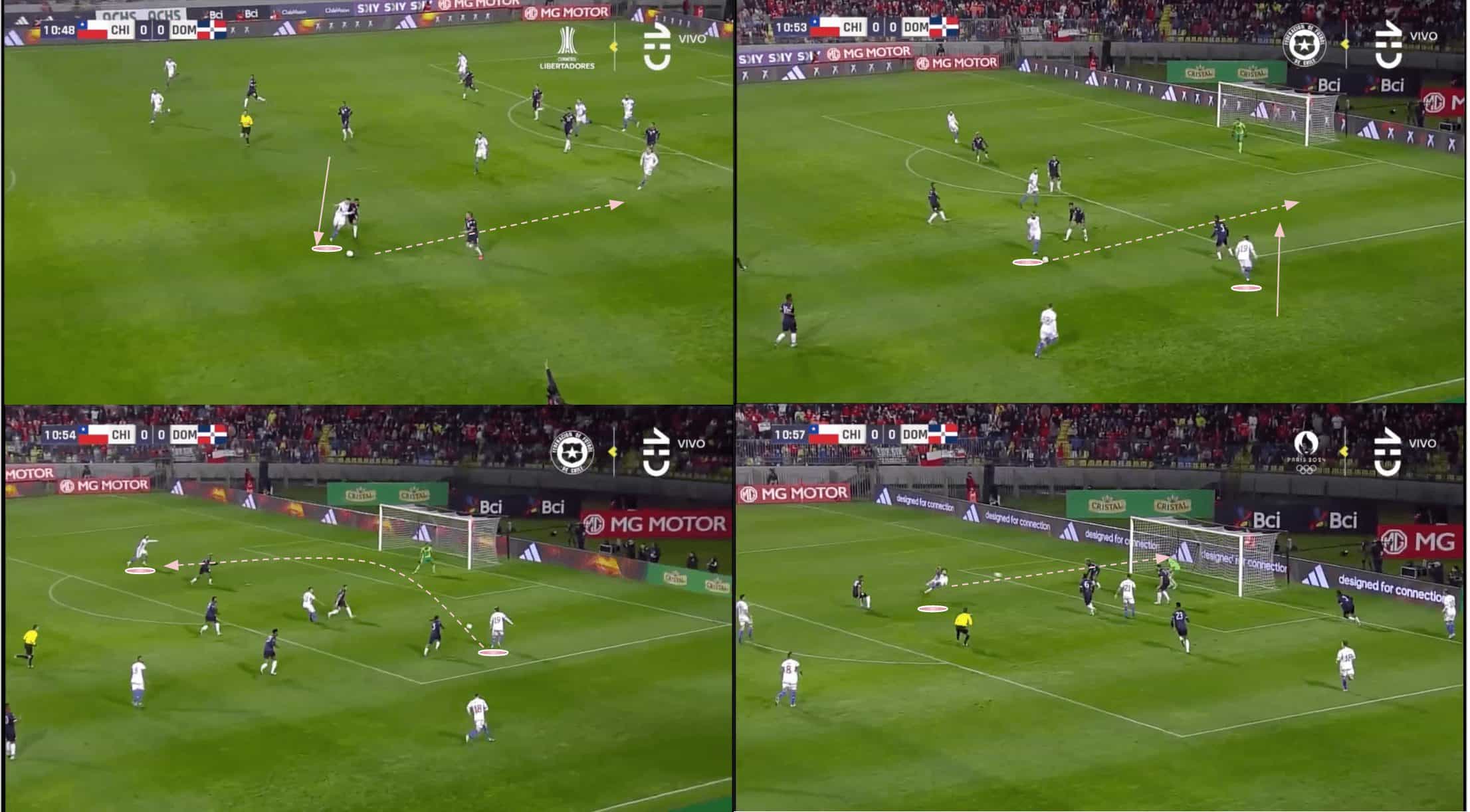
Meanwhile, expect to see Chile counterpressing heavily in defensive transitions, using this phase of play as an important method of chance creation just as much as it’s a key aspect of their defensive tactics and efforts to halt the opposition’s attempted counterattack.
Figure 10 shows one example of a Chilean midfielder swiftly closing down and dispossessing an opponent just after La Roja’s own attack had ended, preventing the opponent from exiting their own third and forcing the ball straight back into Chilean feet just on the edge of the opponent’s penalty area.
La Roja manage to enter the opposition’s box here and create a good goalscoring opportunity near enough in the centre of the box, which Brereton-Díaz finished in acrobatic fashion, adding style to substance in this case.
In defensive transitions deeper, as mentioned earlier, Chile will typically have a 2-2 base at the back to protect their goal and try to slow down opposition counterattacks while they buy time for their attackers and full-backs to retreat, get behind the ball and put more pressure on the ball carrier.
In general, this Chile side tends to have good energy levels and defensive commitment, making their defensive transitions and high pressing in the settled high block quite solid.
However, with an ageing squad, you do see a dropoff over the course of the game, and players’ minutes and levels of energy out of possession will have to be managed very carefully.
Furthermore, especially on the right of defence, where we may find Isla and Medel, pace will be an issue for Chile, and opponents will try to exploit them with fast-paced wingers, 1v1 take-ons and balls in behind.
Forwards
Apart from the attackers already mentioned, Víctor Dávila is the one most likely to get a decent number of minutes at Copa América, with the versatile CSKA Moscow attacker capable of providing a decent option instead of Vargas at centre-forward, Brereton-Díaz at left-wing or Osorio on the right.
Versatility is always desirable in tournament football, so he should make the trip to the competition as part of Gareca’s squad.
Marcos Bolados is another who may provide competition for Osorio on the right or even for Brereton-Díaz on the left — making him a decent squad option for Gareca.
Alexander Aravena is a 21-year-old attacker who’s featured all across the forward line for Chile at some point in his nine senior international appearances thus far.
He could also benefit from some tournament experience, and while he does give Gareca different options, he may be of use in the squad, as does Jean Meneses—the final attacker we’d predict making Gareca’s Copa América squad.
Midfielders
In midfield, we’re quite confident with our starting selections of Pulgar and Echeverri behind Sánchez, though Marcelino Núñez of EFL Championship side Norwich City will also be hoping to get a chance to show what he can do on the Americas’ grandest footballing stage this summer.
At the time of writing, he even scored a goal for his country in their latest international friendly against France back in March.
Veteran Arturo Vidal could also get some minutes, but we predict those minutes will mainly come from the bench if he does go to the tournament.
The 37-year-old is capable of providing cover in midfield or defence.
Meanwhile, Club América’s Diego Valdés could be a decent attacking midfield backup for Sánchez, with the 30-year-old also capable of playing out on the wing.
We predict Toluca’s Claudio Baeza will make the trip to Copa América as a more defensive midfield option, should Gareca need to make that kind of change to his lineup.
Defenders
As well as Medel and Maripán, who we’ve already mentioned as our predicted starting centre-backs for Chile at this summer’s Copa América, we expect Paulo Díaz of Argentina’s River Plate, Matías Catalán of CA Talleres and Igor Lichnovsky of Club América to travel to the tournament to provide options for Gareca in the centre of defence, with Catalán also viable as a right-back option.
Meanwhile, though we’ve got Isla starting at right-back, we could easily find Felipe Loyola getting some game time during the competition, as is the case for Tijuana’s Nicolás Díaz, who we see as a backup left-back for Toulouse’s Gabriel Suazo, coming into Copa América off the back of an excellent Ligue 1 campaign this past season.
Key Player
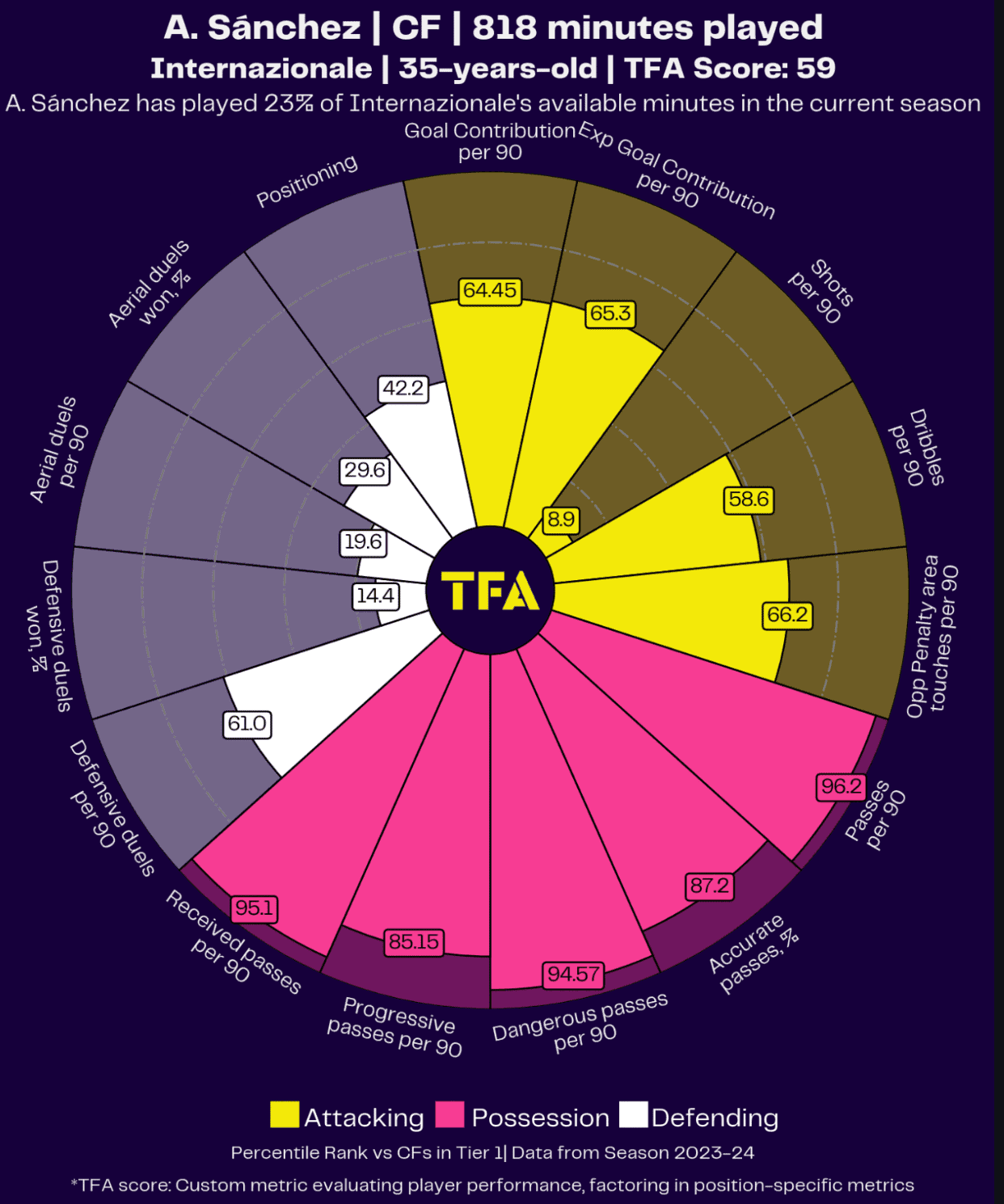
Moving onto our ‘key player’ section, we’ve selected Alexis Sánchez as La Roja’s main man in this tournament despite his relatively low number of league minutes for Inter in Serie A this past season and the fact he is entering the tournament as a 35-year-old, simply because we don’t see any other Chilean players either playing a more pivotal role in Gareca’s system or being more capable of producing a moment of individual magic than the ex-Barcelona, Arsenal and Manchester United man.
As per the pizza chart above, highlighting Sánchez’s performance in key metrics across the board when compared with other centre-forwards from Europe’s top-five leagues over the last calendar year, the Inter man stands out massively in possession stats, getting involved in his team’s play quite a lot and playing plenty of dangerous passes, indicative of the key role he’s capable of playing at the very highest level in terms of chance creation.
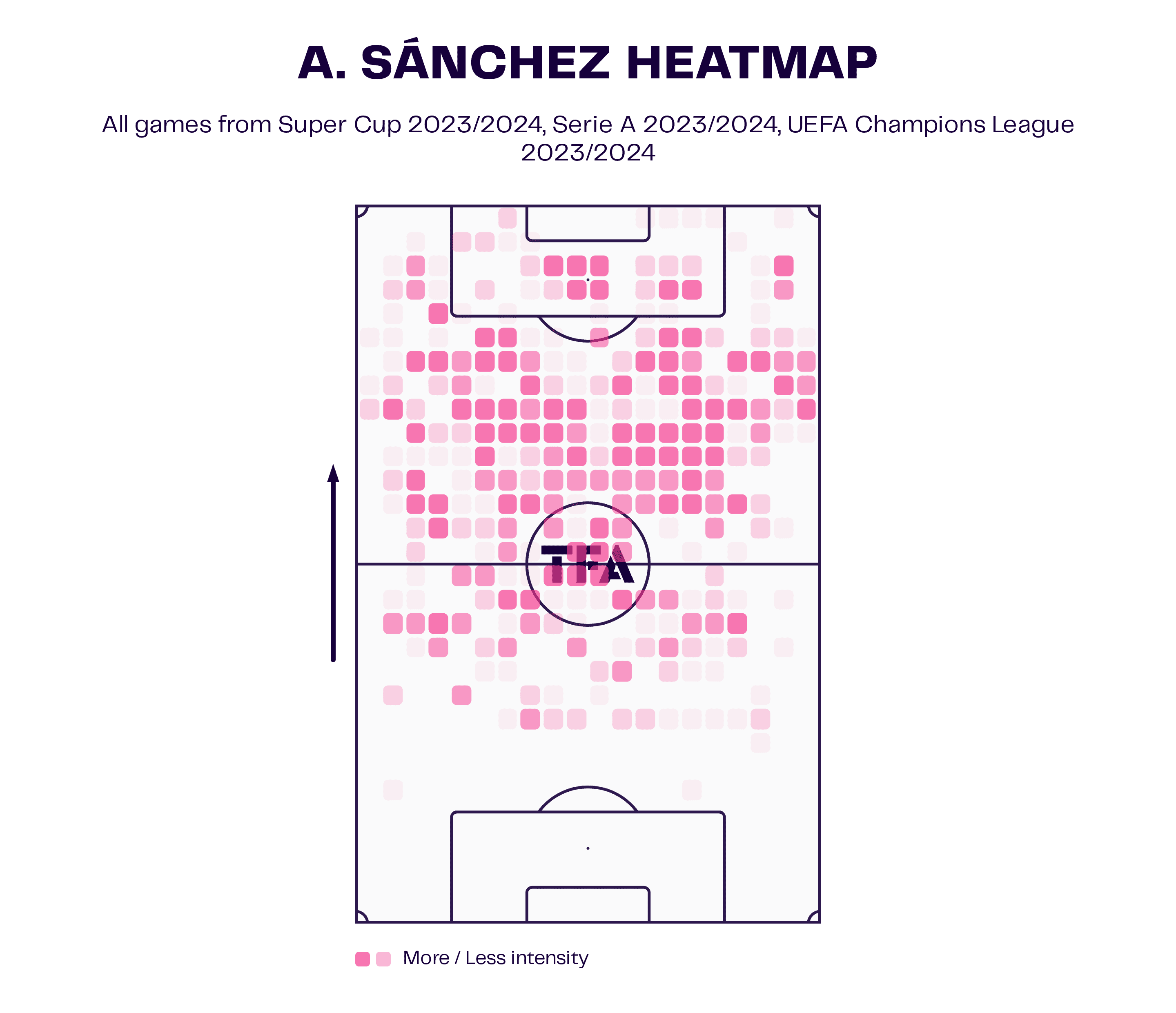
Sánchez was mainly found outside the box, in typical ‘second-striker’/’10’ positions over the past season.
He doesn’t just stay centrally, getting involved in the half-spaces a lot too, but not any one in particular, frequently drifting into both the left and right inside channel.
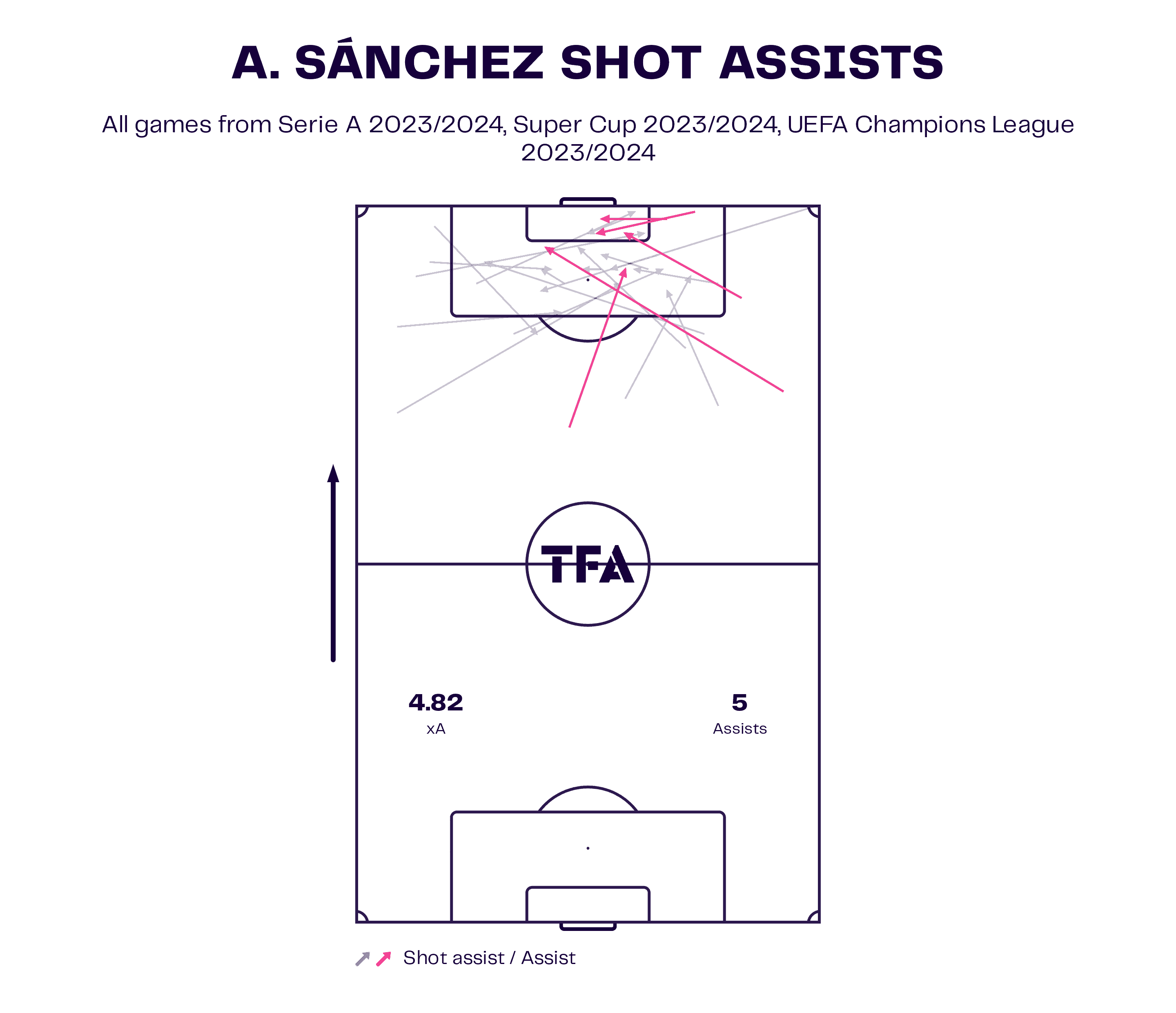
From those positions, Sánchez generated 4.82 expected assists, resulting in five actual assists for Inter this past season — see the main areas from which he generated shots for teammates highlighted on figure 13 above.
Tournament prediction
For us, second place in Group A—behind likely group winners Argentina—is a toss-up between Chile and Canada.
It really could go either way, depending on several factors, including luck and which team’s key players show up the most in key moments.
Should Chile make it out of the group, it wouldn’t be a surprise to see them exit the tournament in the next round, but it also shouldn’t be a massive shock if they do bow out in the group stage with Jesse Marsch’s Canada progressing ahead of them.

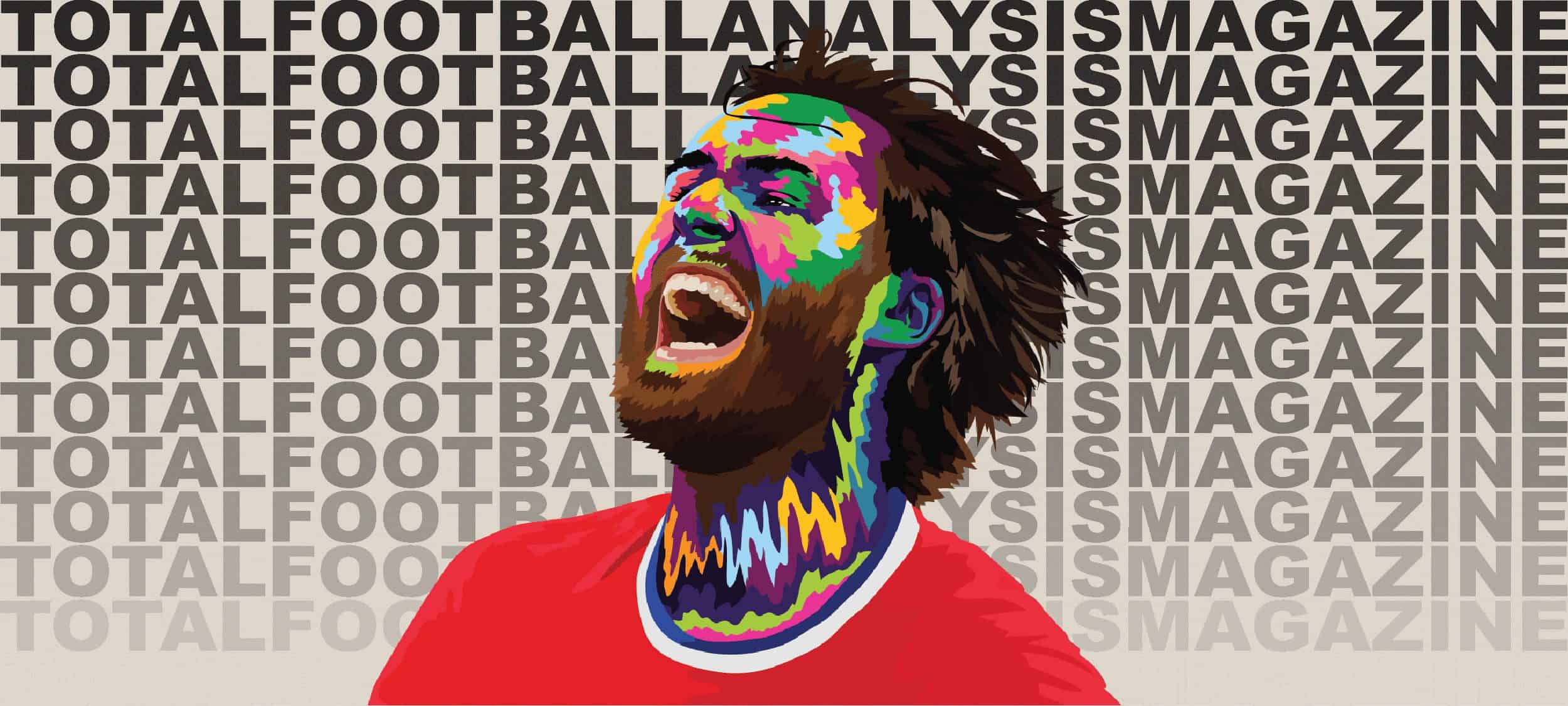



Comments